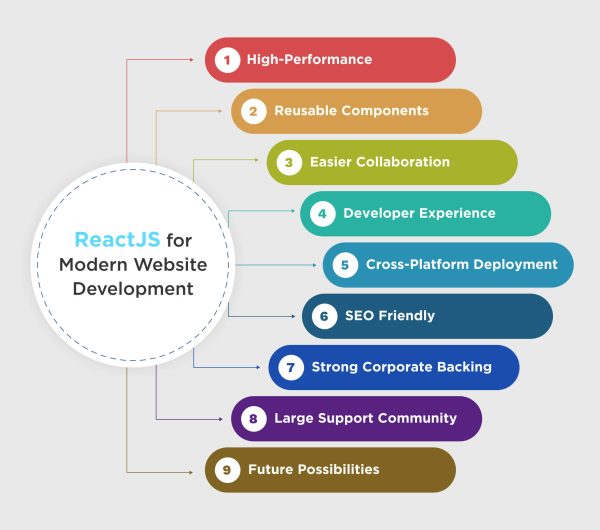ReactJS is a powerful JavaScript library, highly favored by developers for building dynamic, high performing, responsive web applications. Its simplicity and scalability have propelled it to the forefront of modern web development.
Dynamic Web Applications with ReactJS

ReactJS enables developers to build dynamic web applications with ease. Thanks to its Virtual DOM, updates and rendering are quick and efficient. It’s this dynamic nature that allows for a seamless user experience, free of slow loading pages and laggy responses.
- Component Should Update: Utilize the lifecycle method `shouldComponentUpdate` to prevent unnecessary re-rendering of components. This method decides if a component should be updated in response to a state or props change.
- Lazy Loading: Implement lazy loading to defer initialization of objects until they are needed. This can significantly improve performance for applications with heavy or dynamic content.
- Code Splitting: Use code splitting to divide your code into smaller chunks which can then be loaded on demand or in parallel. This reduces the load time of your application.
- Minimize DOM Manipulation: As DOM manipulations are expensive, minimizing these operations can considerably improve performance.
- Use Keys in Lists: When rendering lists in React, always use keys. Keys help React identify which items have changed, are added, or are removed, enhancing re-render efficiency.
- Use PureComponent or React.memo: Using PureComponent or React.memo can prevent unnecessary renders by doing a shallow comparison of the current and new props.
- Avoid Inline Function Definition in Render: Inline functions can lead to unnecessary renders, as a new function is created with each render. To optimize, define the function outside of the render method.
Component-Based Architecture
One of the most notable features of ReactJS is its component-based architecture. This structure allows for code reusability—a significant time-saver for developers. Additionally, it introduces a level of abstraction that enhances better code organization and aids in maintaining a clean and readable codebase.
- Efficiency: ReactJS creates its own virtual DOM where your components are kept. This approach provides high application performance and guarantees efficient updates and rendering of your components.
- Reusable Components: Components are reusable in ReactJS. This means developers can reuse the components that they have already developed, which dramatically reduces the development time.
- Unidirectional data flow: A one-way data flow means that when designing a React app, developers often nest child components within parent components. This principle makes the code more stable and also makes it easier to debug.
- Community Support: ReactJS has a large community of developers. This means that you can always find a wealth of libraries and components that are ready to be used, which can speed up the development process.
- SEO Friendly: ReactJS significantly reduces the page load time through faster rendering speed, which is immensely beneficial for any website’s search engine ranking.
- Easy to Learn: Compared to other frontend frameworks, ReactJS is easier to learn because of its simplicity and straightforward application structure.
- Use of JSX: JSX makes it easier to read and write code, preventing coding errors, and enhancing application performance through optimization.
Responsiveness with ReactJS

When it comes to building responsive web apps, ReactJS is a standout choice. It effortlessly handles real-time updates, maintaining high performance even with heavy user interaction and data updates. Whether it’s a single-page application or a complex web app with numerous views and features, ReactJS can deliver a responsive, user-friendly experience.
- Virtual DOM: ReactJS creates a virtual DOM and keeps it in memory. Whenever any changes occur, they are first implemented on the virtual DOM, drastically reducing direct manipulation of the actual DOM and subsequently improving app performance.
- Component Life Cycle: ReactJS provides several lifecycle methods that you can override to run code at particular times in the process. These methods can be used to perform actions based on changes to component state or props, enabling a high degree of control over the UI.
- Flexibility: ReactJS is not opinionated in terms of how you structure your project. This provides developers with the flexibility to choose the best architecture, libraries, and tools for their specific needs.
- Strong Toolset: ReactJS provides a robust toolset for development, including a handy set of devtools for Chrome and Firefox, and extensions like React Router and Redux to help manage application state.
- Future-Proof: ReactJS is maintained by Facebook and is extensively used in their products, ensuring that the library stays up-to-date and relevant in the fast-paced world of web development.
A Feature-Rich Ecosystem

ReactJS web development has a rich ecosystem that includes tools and libraries like Redux and React Router. These resources further enhance its capabilities, allowing developers to build feature-rich, state-of-the-art applications.
- Use of Keys: In ReactJS, assigning unique keys to list items helps improve application performance by enabling efficient re-rendering of components.
- Lazy Loading: This technique involves loading components only when they’re needed, reducing initial load time and memory usage.
- ShouldComponentUpdate: This lifecycle method can be used to prevent unnecessary re-rendering of components, improving app performance.
- Minimize DOM Manipulation: Use of the virtual DOM in ReactJS reduces real DOM manipulation, which is typically slow and performance-costly.
- Webpack Module Bundler: Use Webpack to bundle your modules and reduce the number of HTTP requests, thereby improving loading time.
- Immutable Data Structures: Using immutable data structures can help optimize performance by reducing the complexity of change detection.
Conclusion
In conclusion, ReactJS brings together the best of dynamism, responsiveness, and a robust feature set to aid developers in creating efficient, user-friendly web applications. It’s no wonder then that many leading tech companies, including Facebook, Instagram, and Netflix, have turned to ReactJS for their web development needs. Remember, with great power comes great responsibility, and it is incumbent upon us as developers to keep the applications we build secure, efficient, and user-friendly.




